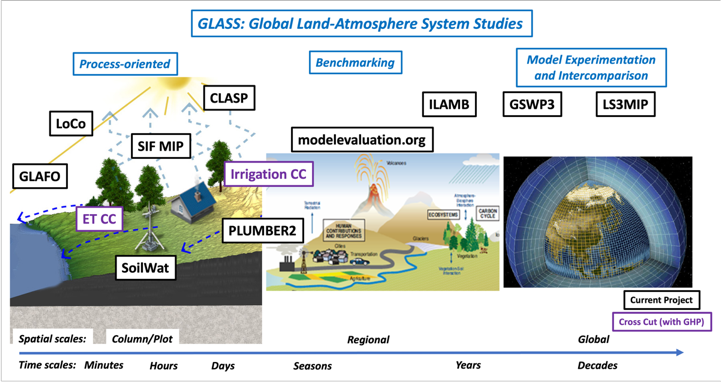Land modeling has shown rapid development in recent decades. Where energy and water fluxes were the primary focus of studies through the 1990s, the 2000s brought increasing attention to the global carbon cycle and triggered the development of model characterizations of vegetation phenology, dynamic vegetation structure, and carbon pools. Continued development through the 2010s and into the 2020s has broadened the capacity of those models with improved representations of soil physics and hydraulic properties, plant water stress (including plant hydraulics) and root water extraction, wetlands, urban areas, interactions between irrigation and ground water, nutrient cycles, cryosphere processes and more.
This expanding scope is driven by the growth of interdisciplinary studies of the Earth system, including observational efforts to understand processes from the sub-surface (e.g., impacts of soil characteristics on groundwater recharge), to the surface (e.g., impacts of soil moisture availability and vegetative controls on surface flux partitioning), to the near-surface atmosphere (e.g., impacts of surface fluxes on development of the planetary boundary layer).
The Global Land-Atmosphere System Studies (GLASS) Panel encourages these developments by coordinating the evaluation and intercomparison of the new generation of land models and their applications to scientific queries of broad interest. Thus, a key objective of GLASS is model development and evaluation, emphasizing comparisons to observational benchmarking datasets. We now use the more holistic term land model (rather than land surface model), since these models are no longer limited to a surface representation of the atmosphere’s bottom boundary conditions. In fact, because the land component is tightly coupled to the atmosphere in many ways, GLASS projects also address interactions between the land and the atmosphere, with scales of interest ranging from observational site-scale process understanding applicable to sub-diurnal to seasonal timescales, out to continental and global climatological understanding of the interconnected water, energy, and carbon cycles.
The schematic below highlights the primary emphasis of current GLASS projects in three areas: process understanding, benchmarking, and model intercomparisons.
For more information about a specific project click on its name in the image.
Details of all projects can be found here.

Hover over the Panels tab in the Top Menu for detailed information about Panel members, etc.

